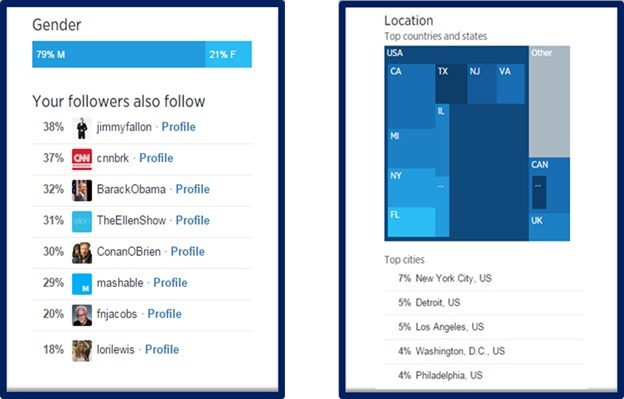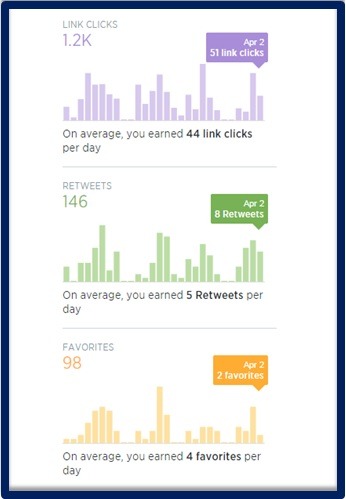Lori Lewis sent another amazingly helpful memo to Jacobs clients earlier this week about strategically using Twitter analytics to measure the performance of tweets – and a station or personality’s social strategy.
My fear is that very few managers will take the time to put it into use. And that points to a larger gap between social media and how broadcasters measure its success. For the most part, there continue to be the time-honored fixation with two metrics – ratings and sales. Whether meters or diaries from Nielsen on the one hand, or Miller Kaplan’s or some other accounting firm that provides sales data on the other, these are the numbers that move everyone’s needle in radio. It’s how managers are paid and bonused, so it’s understandable that everyone is so laser-focused on them.
But as we know, both are flawed. Nielsen will tell you their measurements are estimates, as Arbitron reminded us for decades. We’re dealing with limited panel samples of meters and weekly diary data that can’t possibly capture market listening with total accuracy.
But that doesn’t stop us from slicing, dicing, and parsing the data, counting meters, adding new columns, and doing everything we can to get a bead on how the ratings can inform programming decisions – often inaccurately.
But in the digital space, the metrics are far more informative, not to mention a real reflection of what works. And they can tell us a great deal more about response, reaction, and behavior. And yet, broadcasters often squander the chance to learn more about the optimal ways to hone their skills and their content in the new media arena.
Take “memes” for example. In a blog post earlier this year – “Welcome to Meme City” – we looked at how videos of cats playing poker can quickly pump up Facebook “likes.” And in the process, we showed how the analytics also reveal that brands overly reliant on these memes usually end up garnering thousands of “likes” in places like Cairo or Bangalore. Last I checked, Nielsen is not measuring either metro, nor are many sales coming from those markets.
Now Lori is introducing many broadcasters to a new suite of Twitter Analytics. If you navigate to Analytic.Twitter.com and enter in your station’s Twitter login information, a whole new world of data opens up. This is important because your social media efforts potentially impact even more listeners than you have during an average day of listening. And of course, the ability for a tweet to be shared – in the form of retweets and favorites – means that if you actually study your social media activity to learn what resonates, you just might reach a whole new world of listeners and fans.
These Twitter Analytics show you other people, businesses, and media outlets that your followers follow, as well as the top five cities where your tweets originate.
This is interesting info, but the real money numbers focus on “active metrics” – link clicks in your tweets, along with retweets and favorites. These are all indicators that Twitter activity is working, causing reactions from those who read them.
These are richer data points than seeing how a song tests or whether you’re “the concert authority.” These numbers tell you whether your messaging and interactivity are truly connecting with listeners in the social space and whether they’re sharing your content with friends, relatives, and fellow workers.
Here we are in 2015 and the good news is that virtually every radio station and personality is active in some way in the social space. This is progress, and I think Lori has been one of the key influencers of this trend.
But it’s one thing to open a free account and start firing off posts and tweets. It’s another to have a bona fide strategy that guides your social interaction. In the same way, you wouldn’t randomly program your radio station – playing whatever songs you like and talking about whatever topics come into your head – the social space requires that same level of analysis, discipline, and thought.
PDs are marketers are typically dead serious about the ways in which their stations are programmed and promoted. So isn’t it time to devote time, energy, and brain cells to gaining a better understanding of what it takes to succeed in the social space?
In radio programming, the numbers are helpful, but creating and guiding an on-air sound still contains a great deal of guesswork and risk-taking. It’s the nature of the beast. But as it relates to social media success, the analytics are there that richly define success, failure, and everything in between.
If we took the time to study them and learn from them.
It’s time to get serious about social.
- Can Radio Afford To Miss The Short Videos Boat? - April 22, 2025
- Media And Technology In 2025: Believe It Or Not! - April 18, 2025
- In Radio, You Just Never Know - April 17, 2025







Leave a Reply